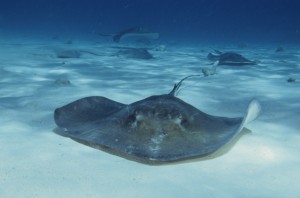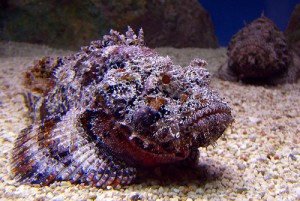And back by popular demand, it’s another installment of “Name that Poisonous Beast!”
Name this poisonous beast!
A)
And it’s stony neighbor:
B)
- A) Stingray (Dasyatidae):
- Tail with one or more barbed stingers and 2 ventrolateral venom-containing grooves
- Local effects:
- Puncture wounds: severe pain, edema, cyanosis, erythema, petechaie, local necrosis, ulceration and delayed wound healing
- Often in lower extremity, but mortality can occur if barb penetrates major vessels, heart or other vital organs (think Steve Irwin – a barb to the heart!)
- Treat abdominal/thorax wounds as any other penetrating trauma
- Often in lower extremity, but mortality can occur if barb penetrates major vessels, heart or other vital organs (think Steve Irwin – a barb to the heart!)
- Puncture wounds: severe pain, edema, cyanosis, erythema, petechaie, local necrosis, ulceration and delayed wound healing
- XR for foreign body (i.e. retained barb); ensure removal
- Rarely, systemic symptoms:
- Syncope, nausea/vomiting, diarrhea, diaphoresis, muscle cramps, fasciculations, abdominal pain, seizures, hypotension
- Treatment:
- Immerse affected area in hot water (110-115 F) for 30-90 minutes (direct effect on heat-sensitive toxin)
- Supportive care/ensure tetanus UTD
- For deep puncture wounds, especially w/foreign bodies, prophylactic antibiotics
- Cover staph/strep and vibrio: first-generation cephalosporin (or clindamycin + levaquin if MRSA concern/penicillin allergy) + doxycycline
- No antivenom
- B) Stonefish (Synanceia); of the Scorpaenidae family, which also includes the less poisonous Pterois (lionfish, zebrafish, butterfly cod), Scorpaena (scorpionfish, bullrout, sculpin)
- Stout, powerful spines with highly developed venom glands
- Reported mortalities, but likely 2/2 sepsis from superinfection
- Local effects:
- Puncture wounds similar to sting rays, surrounded by cyanotic tissue
- Excruciating pain which may spread to entire limb and regional lymph nodes, peaking at 60-90 minutes and lasting up to 12 hours; mild subsequent pain may persist for days to weeks
- Subsequent edema, erythema, warmth; may involve entire limb, rarely w/tissue necrosis (as opposed to stingray)
- Possible vesicle formation, which may be followed by tissue sloughing, cellulitis and hypesthesia
- XR for foreign body (i.e. retained barb); ensure removal
- Systemic effects (less common):
- Nausea, vomiting, headache, diaphoresis, muscle weakness, dyspnea, hypotension, syncope
- Treatment:
- Immerse affected area in hot water (110-115 F)
- Supportive care/ensure tetanus UTD
- Antivenom: 1 ampule for every 1-2 punctures, up to 3 ampules for more than 4 punctures; diluted in 50-100ml NS and run over >15min
- Provide if adequate relief not obtained from hot water immerse and parenteral analgesia; may also be effective for systemic effects
- Equine antisera with allergy risks; can pretreat w/antihistamine, steroids, and/or epinephrine
- Excepting deep puncture wounds and the immunocompromised, prophylactic antibiotics are not warranted
- Stout, powerful spines with highly developed venom glands


